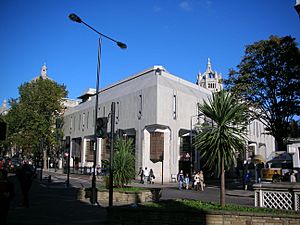Ismaili Centre, London facts for kids
Quick facts for kids The Ismaili Centre, London |
|
|---|---|

View of the Ismaili Centre, London from Exhibition Road, with the Victoria and Albert Museum visible in the background
|
|
| Religion | |
| Affiliation | Nizari Ismaili Muslim |
| Leadership | His Highness the Aga Khan |
| Location | |
| Location | Cromwell Gardens, London, SW7 |
| Architecture | |
| Architect(s) | Casson Conder Partnership |
| Architectural type | Jamatkhana |
| Groundbreaking | 6 September 1979 |
| Completed | 1985 |
| Website | |
| http://www.theismaili.org/ismailicentre/london | |
The Ismaili Centre, London is a special building in South Kensington, London. It's one of six similar centres around the world. This centre is a place where Ismaili Muslims meet for religious activities, social events, and cultural gatherings. It was the first centre of its kind built in the Western world.
Contents
Building the Centre
The Ismaili Centre in London officially opened on 24 April 1985. The Prime Minister of the United Kingdom at the time, Margaret Thatcher, was there. Also present was His Highness the Aga Khan, who is the 49th Imam, or spiritual leader, of the Ismaili Muslims. This centre was the first place specifically designed for the Ismaili community in the Western world.
Ismaili Muslims have lived in the United Kingdom since 1951. They first had a centre at Kensington Court. Later, in 1957, they moved to Palace Gate. As their community grew, they needed a bigger space. So, in the 1970s, they bought land at Cromwell Gardens.
The foundation stone for the new Centre was laid on 6 September 1979. Lord Soames, a government official, did this, with the Aga Khan watching. Construction of the building started in July 1980.
Where the Centre is Located
The Ismaili Centre is in Cromwell Gardens in London's South Kensington area. This is a well-known spot with a long history. Right across the street to the north is the famous Victoria and Albert Museum. To the west, you'll find Exhibition Road. The closest underground train station is South Kensington. It's connected by an underground path to the museums nearby.
The land where the Centre stands was once owned by a theatre group. In 1937, they wanted to build a National Theatre there. But World War II started, and they later realized the land was too small. So, their plans didn't happen.
In the 1860s, seven houses were built on this land, which was called "Cromwell Gardens". By 1912, the area became very busy, making the houses less appealing. Before the Ismaili Centre was built, the site had a car-hire place and a temporary office building.
Unique Architecture
The area around the Ismaili Centre has many grand buildings. These include the Natural History Museum and the Victoria and Albert Museum. The Centre's design needed to fit in with these buildings. But it also had to show its Islamic style.
The architects, Casson Conder Partnership, created a very modern building. The outside of the Centre uses light colours like whites, greys, and blues. These colours help it blend with the surrounding buildings. The Centre looks calm, but it clearly has an Islamic feel. A special part of its design is the charbagh garden on its roof.
Not everyone liked the design at first. In 1982, it even won an award from Private Eye magazine for the "worst new building of the year." They said it looked "lumpish" and "banal."
Purpose of the Centre
The Ismaili Centre was created to promote "peace and dialogue." It also encourages the search for knowledge and human dignity. It shows how the Ismaili community sees Islam as a thoughtful and spiritual faith. When the Centre opened, the Aga Khan said it was a "token of understanding between East and West." The Centre has worked hard to achieve this goal.
For over 25 years, the Centre has welcomed the public. It hosts exhibitions, lectures, and discussions. Thousands of people have explored the building through guided tours. These tours are led by trained volunteers. Many important people have visited, including royalty, prime ministers, and religious leaders. Since 2000, the Ismaili Centre has also taken part in Open House London. This is an annual event where many buildings open their doors to the public.
By visiting the Centre and joining its programs, people can learn more about Islam. They can also understand Muslim people and their values better. Prince Charles once spoke about this at an exhibition held at the Centre. He praised the Ismaili community for using "intellectual and cultural exploration" to connect with others. He also noted their commitment to being good citizens while keeping their own traditions. He said that shared values like humility, honour, and hospitality are key to the Centre's excellent work.
More Information
- Ismaili Centres around the world (official website: http://www.theismaili.org/ismailicentres)
- Ismaili Centre, Vancouver (official website: http://www.theismaili.org/ismailicentre/burnaby)
- Ismaili Centre, Lisbon (official website: http://www.theismaili.org/ismailicentre/lisbon)
- Ismaili Centre, Dubai (official website: http://www.theismaili.org/ismailicentre/dubai)
- Ismaili Centre, Dushanbe (official website: http://www.theismaili.org/ismailicentre/dushanbe)
- Ismaili Centre, Toronto (official website: http://www.theismaili.org/ismailicentre/toronto)

